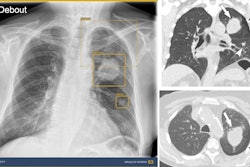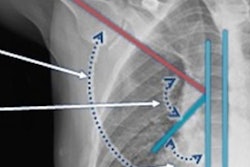An AI algorithm may make dynamic digital radiography (DDR) more efficient by automatically measuring kinematics involved in certain shoulder injuries, according to a presentation delivered November 29 at RSNA.
John Sabol, PhD, a scientist at Konica Minolta, described a deep-learning (DL) algorithm designed to measure what’s known as the scapulohumeral rhythm (SHR) of the shoulder. The SHR is the motion between the scapula and the humerus, and visualizing this motion can provide insights into pathology of injuries such as rotator cuff tears, Sabol noted.
“Although dynamic visualization of anatomy is useful to detect numerous pathologies, quantitative assessment of joint motion may improve sensitivity and specificity of DRR,” Sabol said, in a scientific session on musculoskeletal imaging.
DDR is an emerging imaging technique that uses a pulsed x-ray source to acquire a series of radiographs at six to 15 frames per second. These images are then processed to visualize joints in motion. The technology has been applied to several thoracic and musculoskeletal imaging applications and notably has previously been used to visualize the SHR.
The potential radiation dose to patients with DDR is about 30% higher than when using conventional static film x-ray, yet about 40% lower than a standard MR arthrogram, which requires the use of a contrast agent, Sabol noted.
In this study, the goal was to develop a DL algorithm that can automatically determine the SHR, which normally requires complex and time-consuming manual calculations by clinicians and thus is rarely performed in routine clinical cases, he said.
The prototype DL algorithm was trained on 447 images from 267 cases to recognize the humerus and scapula positions, calculate the required scapulothoracic and glenohumeral angles, and thus determine the SHR across the complete range of abduction.
The performance of the algorithm was then evaluated by comparing its measurements with manual human reader measurements on a unique data set of 73 shoulder exams (23 normal controls, 41 rotator cuff tears, and nine adhesive capsulitis cases), with the AI and human measurements compared using intra class correlations (ICC).
A total of 219 measurements were made by both the AI algorithm and manual physician methods. The inter-rater reliability among two experts who manually measured the SHR was excellent with an ICC of 0.87. This indicates that the SHR is an effective method for differentiating between injured shoulders and normal cases, Sabol noted.
In addition, the correlation between the AI algorithm and the human results was moderately reliable with an ICC of 0.58, according to the analysis.
“DDR with automated tools may be a practical and efficient means for routine analysis of scapular humeral rhythm and scapular kinematics in a typical patient population,” Sabol said.
He noted that further training using more specific anatomic landmarks and a larger dataset is required to improve the agreement with manual measurements of SHR, and the group is currently working on a second iteration of the model.
“Our prototype algorithm showed moderate success and we have identified a clear path towards improving it,” Sabol concluded.



















